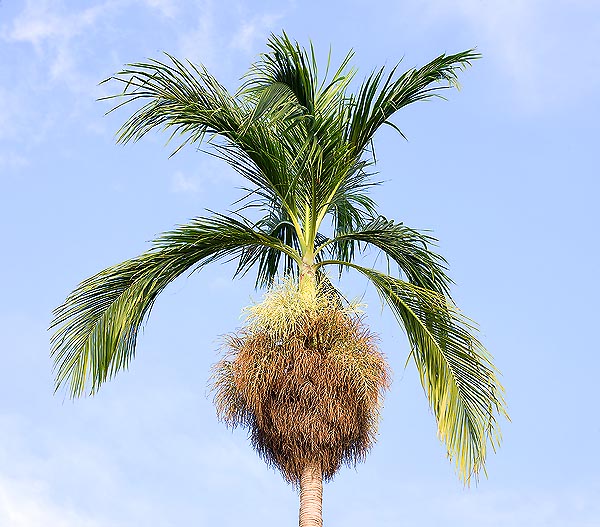Family : Arecaceae

Text © Pietro Puccio

English translation by Mario Beltramini

In nature, Bentinckia nicobarica of Nicobar Islands is at high extinction risk © Giuseppe Mazza
The plant is native to the humid forests of the Nicobar Islands (Indian Ocean), where it grows at low altitudes close to the coastline.
The genus is honoured to William Henry Cavendish Bentinck (1774-1839), English politician who was general governor of the Indies; the name of the species refers to its origin place.
Common names: Bentinck’s palm, Nicobar palm (English); palmeira-de-Nicobar (Portuguese).
Bentinckia nicobarica (Kurz) Becc. (1885) is a monoecious plant with single stem, 15-18 m tall and a diameter up to 25 cm, of greyish colour in the oldest part and on which are evident the rings, mark of the junction of the old leaves.
The leaves, on a short petiole, are pinnate, 1,6-2,4 m long, elegantly bent and with the rachis having a slight torsion; the foliar base, of green grey colour, wraps entirely the stem for a length of about 1,8 m, forming a sort of elegant capital.
The pinnulae are lanceolate of dark green colour, 30-50 cm long, regularly inserted along the rachis, but in the young plants where they are united each other in groups of various width. The inflorescences come out under the leaves, are ramified with flowers placed in the typical triad (a female flower between two male ones). The fruits are obovoid, 1,5 cm long and 1,2 cm of diameter, of brown or reddish brown colour when ripe, containing one seed only. It reproduces by seed which germinates in 2-3 months at the temperature of 24-28 °C.
Plant of great ornamental and landscape value due to its slender stem and the elegant foliage; of great effect is placed lined along the alleys or in numerous groups. It is suitable for being cultivated exclusively in the tropical and humid subtropical zones, as it does not stand temperatures close to 0 °C, the lowest ones should maintain over the 10 °C, and the lack of humidity. In the best climate conditions, if placed in full sun and on soils rich of organic substance and well drained, it is one of the fastest growing palms.
The local populations eat the vegetative apex (palmito), which causes the death of the plant, and utilize the trunks in the constructions of the huts, jeopardizing the survival of the species, already decimated by catastrophic natural events; the International Union for Conservation of Nature (IUCN), has inserted this plant into the list of plants at extremely high risk of extinction in nature in the next future (EN, Endangered).
Synonyms: Orania nicobarica Kurz (1875).
→ For general notions about ARECACEAE please click here.
